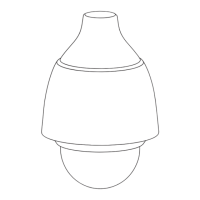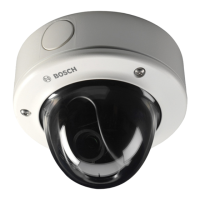Do you have a question about the Bosch NDC-255-P and is the answer not in the manual?
Covers general safety warnings and important instructions for operating the unit safely.
Details FCC/ICES compliance, UL certification, and Bosch product notices including disposal.
Information regarding software copyrights and licenses used in the firmware.
Outlines the key features and capabilities of the IP Dome Camera 200 Series.
Instructions for unpacking the camera and handling the sensitive components carefully.
Step-by-step guide on how to disassemble the camera housing unit.
Instructions for installing the microSDHC card into the camera.
Details on connecting the camera to a power source via DC or Ethernet.
Information on connecting the camera to a network using the Ethernet port, including PoE.
Description of the camera's Input/Output and audio connector pins and their functions.
Guides on physically mounting the camera and adjusting its physical position.
Specific steps for adjusting the focal length and focus of the NDC-255-P model lens.
Procedures for resetting the camera to factory defaults and completing the unit assembly.
Specifies the minimum requirements for the computer and browser to connect to the camera.
Details how to connect to the camera via a web browser, including IP configuration, security, and protected networks.
Information on the connection status and available interface options like Livepage, Recordings, and Settings.
Overview of the Basic Mode menu structure and how to navigate and save settings.
Configuration for device identification, user access levels, passwords, and date/time synchronization.
Network configuration, video encoding profiles, audio settings, recording options, and system overview.
Introduces the Advanced Mode menu, its structure, and saving procedures.
Advanced configuration for camera identification, security passwords, date/time, and video stream stamping.
Customizing the web interface appearance, live page functions, and system logging options.
Detailed configuration of video compression, streams, resolution, quality, and installer-specific options.
Comprehensive settings for managing video recording, storage, profiles, scheduling, and retention policies.
Setup for alarm triggers, VCA analysis, audio alarms, and email notifications.
Configuration of alarm inputs, relay outputs, network parameters, multicasting, and JPEG posting.
Procedures for firmware updates, configuration management, and accessing system information for maintenance.
Description of the Livepage, displaying live video and processor load information.
Detailed explanation of using the Livepage for viewing images, managing logs, saving data, and controlling playback.
A table to help identify and solve common malfunctions like no image or connection issues.
Guidance on contacting customer service and providing necessary information for support.
Warnings and instructions regarding camera maintenance and repair, emphasizing qualified personnel.
Guidelines for passing on the camera and responsibly disposing of it due to hazardous materials.
Detailed technical specifications of the camera, including voltage, power, sensor, resolution, compression, and frame rate.
Information on available accessories, dimensions, weight, operating temperatures, and humidity.
| Maximum resolution | 640 x 480 pixels |
|---|---|
| Supported video modes | - |
| Video formats supported | H.264, M-JPEG, MPEG4 |
| Supported graphics resolutions | 320 x 288 (QVGA), 640 x 480 (VGA) |
| Minimum illumination | 1 lx |
| Sensor type | CMOS |
| Optical sensor size | 1/4 \ |
| Optical zoom | - x |
| Focus adjustment | 1.2 |
| Focal length range | 2.8 - 10 mm |
| Built-in HDD | No |
| Card reader integrated | Yes |
| Compatible memory cards | microSD (TransFlash), SDHC |
| Type | IP security camera |
| Placement supported | Indoor |
| Connectivity technology | Wired |
| Form factor | Dome |
| Mounting type | Ceiling |
| Product color | Black, White |
| Ethernet LAN (RJ-45) ports | 1 |
| Cabling technology | 10/100Base-T(X) |
| Supported network protocols | HTTP, HTTPs, SSL, TCP, UDP, ICMP, RTSP, RTP, RTCP, IGMPv2/v3, SMTP, POP3, FTP, DHCP client, ARP, DNS, DDNS, NTP, SNMP, UPnP |
| Power requirements | 12 VDC / PoE |
| Compliance industry standards | IEEE 802.3af |
| Power source type | PoE |
| Power consumption (typical) | 4.1 W |
| Storage temperature (T-T) | -20 - 70 °C |
| Operating temperature (T-T) | -10 - 50 °C |
| Operating relative humidity (H-H) | 10 - 80 % |
| Height | 102 mm |
|---|---|
| Weight | 548 g |
| Diameter | 135 mm |











